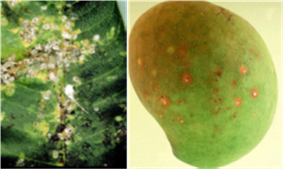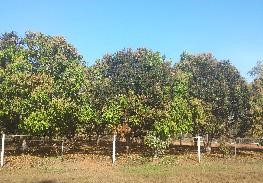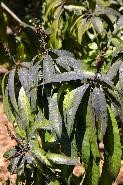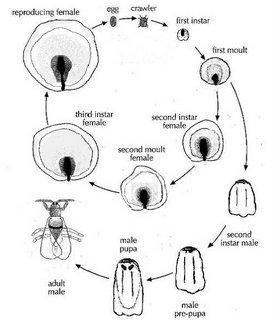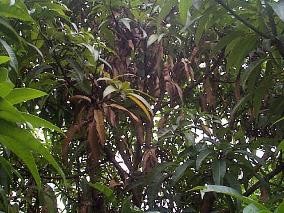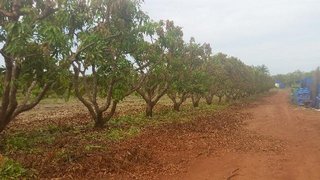Mango Scale and Pink Wax Scale IPM in the Burdekin
Developing and implementing an Integrated Pest Management (IPM) plan for Mango scale and Pink Wax scale in the Burdekin and northern mango production areas is key to controlling these pests. These pests cause minor yet frequent damage to mangoes and other crops, and in badly infested produce, this damage can effect most of the internal fruit resulting in down grading in class and return on crop.
Figure 1.0: damage cause by mango scale, Holmes, R, et al. n.d.
Figure 2.0: Female False mango scale on the left and Pink Wax scale on the right showing the difference, Northern Territory Government Department of Resources, 2010
Mango scale is actually two different scales; False Mango Scale and White Mango Scale. False mango scale appear yellowish with scale covers that are flat, white and in a shape that looks similar to a pear. White Mango scale females are described as being red with scale coverings that are flat, white and circular with a black oval shaped caste skin (Northern Territory Government Department of Resources, 2010). The males of both species are white, rectangular in shape with two or three distinct ridges and are usually clustered round a single female. Pink Wax Scale adults are covered in a pinkish to brown wax substance, are shaped like a globe and are only found on the midrib of leaves (see figure 2).
The scale are sucking pest which feed on the sap from the plant and congregate on parts of the plant that are high in sap, new shoots, leaves (see figure 1), flower panicles, and the fruit stalks/surface. The main component of the sap that the scale feeds on is the protein while other components of the sap are excreted. This scale excretion is high in sugars which provides an ideal medium for the growth of black sooty mould (Department of Agriculture and Fisheries, 2012).
Figure 2.1: Black Sooty mould on mangos, photos courtesy Owens G, 2016.
This mould (see figure 2.1), in sufficient quantities, can impact on the photosynthetic capacity of the plant, which then impacts on the ability of the plant to yield, thus a loss of production occurs. Other pests, such as mango leaf hopper, also produce the high sugar content excretion and have been seen to turn entire orchards black with sooty mould, resulting in major impacts on the plants’ ability to photosynthesise.
Integrated Pest Management
A report by Farm Biosecurity (2013) states that Integrated Pest Management (IPM) combines the use of biological, cultural and chemical practices to control insect pests in agricultural production.
Scale have a joined life cycle where, from eggs to first moult, the sex is not defined however roughly 80% of crawlers will become males and follow one path of the lifecycle, while the remaining 20% will become females and follow a different lifestyle path (see figure 2.2). To gain the best control of the scale’s lifecycle, the crawler stage of the cycle should be targeted through the implementation of an Integrated Pest Management (IPM) strategy. This is particularly important when using the chemical component of the overall approach when managing scale.
Figure 2.1: Scale life cycle, Holmes, R, et al. n.d.
Biological control
There are two main types of biological agents that target scale, parasites and predators. The biological agents are often present in back ground levels where the pests occur and are in a type of balance where their population size rises and falls with the availability of their associated pests. Often is the case where these biological agents are susceptible to similar chemistry that is used to control other pests in crop which can lead to population explosions of the pest. A delay is often occurs in these cases where the pest population rises quickly and the beneficial insects are overwhelmed with numbers and can’t keep up. This is where release of beneficial insects or crop refuges allows a healthy population of beneficial insects to be maintained.
A parasite, Anicetus beneficus, was introduced in 1977 and was shown to be very effective in controlling the pink wax scale where no disruptive pesticides were used. A good indication of whether or not these parasites are present and actively feeding, will be the presence of a small circular hole where it has emerged on the scale.
Releasing parasitised scale in an orchard can boost existing background populations. In addition to this, a number of other commonly found parasitic wasps, including Metapyhcus varis, Scutellista caerulea and Coccophagus ceroplastae, can also be used to feed on scale. It is often worthwhile to leave a tree infested with Pink Wax scale as it acts to increase the parasite numbers in the orchard to the point where spraying is seldom necessary.
There are also a number of common predators that actively feed on scale including the caterpillar (Common, 1990), lacewings (mallada spp), and multiple types of ladybeetles, such as the Black Lady Beetle (Rhyzobius ventralis), Cryptolaemius (Cryptolaemus montrouzieri) and Common spotted ladybird (Hamonia confromis).
Cultural control
Mango scales prefer shaded environment and this can be managed by maintaining an open tree structure when the crop is being pruned following the harvest. In order to remove residual scale populations on plant material, it is recommended to open up the canopy to allow for improved penetration from sprays and access to more light. This will reduce favourable conditions for scale to continue to increase in the off season (see figure 3.0).
Figure 3.0 difference between not cleaned out and cleaned out internal canopy of trees, Photos courtesy of Owens G 2016.
There have also been some observed cases of a significant increase in the population of mango scale shortly after the dust in clay soils has settled on the leaves of the tree. This can be mitigated by the use of wind breaks, or by minimising exposed soil surfaces on the farm, such as tracks and road ways.
Chemical control
Chemical options are often used to control mango scale and, when used in conjunction with both cultural and biological control methods, can provide more effective control of the target while still protecting the beneficial insects. There are three chemical control program options that are currently in use, and example of this can be found on the Movento Users Guide for Mangoes (Bayer Crop Science):
- with no IPM and using broad spectrum insecticides,
- using some IPM and broad spectrum insecticides, and
- using full IPM and selective insecticides to protect beneficial insects in the orchard.
Selection of the right chemical is as important as selecting the right time in the pest’s life cycle to apply the chemical to achieve the desired outcome. Products such as Movento when used with an IPM program provide good control of scale insects in mangoes post-harvest and after flowering.
Summary
Mango scale and Pink Wax scale are minor yet frequent pests in the mango industry across Australia, and cause significant damage to the plant and the volume of the crop. IPM helps to provide good control on individual farms, however when embraced by the agricultural area, it can provide more widespread control and prevent pest incursions from neighbouring farms. Often the scale in these orchards have been indirectly selected for resistance through continued use of chemicals. This area-wide approach can help to generate better control of scale insects, protect current chemistry, as well as prevent chemical failures in the future.
Written by Andrew Owens
Mobile: 0400 989 253
Black Earth Agronomy
References
Farm Biosecurity, 2013, ‘What is integrated pest management?’ viewed 15th September 2016, http://www.farmbiosecurity.com.au/what-is-integrated-pest-management/
Bugs for Bugs, 2015, ‘Cryptolaemus’, viewed on the 15th September 2016, https://bugsforbugs.com.au/product/cryptolaemus/
Common, I, F, B, 1990, ‘Moths of Australia’, Brown Prior Anderson Pty Ltd, Burwood, Victoria, viewed on the 14th September 2016, Ihttps://books.google.com.au/books?id=magzbmvdRvQC&pg=PA70&lpg=PA70&dq=Catoblemma+dubia&source=bl&ots=5LqM1OfkNM&sig=ap4eHZUACO2LrGRaMHfBQqdpwsM&hl=en&sa=X&ved=0ahUKEwiazJzaypXPAhVImJQKHXSEADUQ6AEIIDAB#v=onepage&q=Catoblemma%20dubia&f=false
Salvan, T, 2016, ‘Organic mango production: strategies and methods; Pest and disease management’, viewed on the 20th September 2016, https://www.agric.wa.gov.au/mangoes/organic-mango-production-strategies-and-methods?page=0%2C5
Pinese, B, 2006, ‘Integrated Pest Management (IPM) in Australian Mangoes’, viewed on the 16th of September 2016, http://aciar.gov.au/files/node/774/03%20Pinese%20IPM%20in%20Australia.pdf
Holmes, R, Weinert, M, Wittenberg, L, Pinese, B, Freebairn, C, Bally, I, Frazer, M, n.d. ‘Managing Mango Scale’, viewed on the 14th September 2016, https://www.nt.gov.au/__data/assets/pdf_file/0018/228015/mango_scale_management_poster.pdf
Department of Agriculture and Fisheries, 2012, ‘Pink wax scale’, viewed on the 14th of September 2016, https://www.daf.qld.gov.au/plants/fruit-and-vegetables/a-z-list-of-horticultural-insect-pests/pink-wax-scale#
Bugs for Bugs, 2012, ‘Pink Wax Scale’, viewed on the 15th September 2016, https://bugsforbugs.com.au/2012/03/pink-wax-scale/
Northern Territory Government Department of Resources, 2010, ‘Field Guide to Pest, Beneficials, Diseases and Disorders of Mangoes’, viewed on the 20th of September 2016, https://dpif.nt.gov.au/__data/assets/pdf_file/0006/227832/mango_field_guide.pdf
Bayer Crop Science, n.d. ‘Users’ Guide for mangoes; How to get the best out of movento in mangoes’, viewed on the 20th September 2016, https://www.google.com.au/search?q=movento+user+guide+for+mangoes&sourceid=ie7&rls=com.microsoft:en-AU:IE-Address&ie=&oe=&gfe_rd=cr&ei=eTTrV_bIG6rM8getmai4CQ
The information provided above is based on experience and knowledge developed on farm and as an agronomist. The opinions contained within this post are entire that, and may not apply to a grower's specific circumstance. We recommend consulting your own agronomist to ensure best performance on your own farm.

